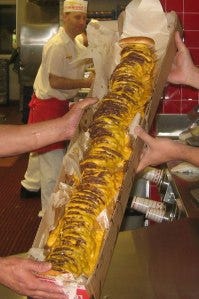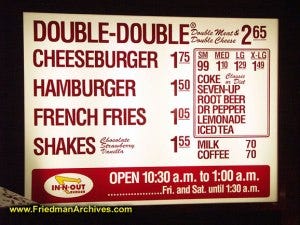Robert Kaplinsky - Motivating Our Students with Real World Problem-Based Lessons
Robert's tasks are great, and I've taught a bunch of them. I didn't come to learn that his site is full of great problems, and that there are plenty more out there. I wanted to see him facilitate a task, and see what one of his problem based lessons looks like in action.
Robert taught this lesson, that starts with a (delicious? digusting?) cheeseburger, and lead eventually to equations and representations. Starts with this image of a cheeseburger with 100 patties and 100 slices of cheese:

What questions do you have? Robert did a great job of validating different questions that folks asked, even the silly ones, but focusing the conversation on the mathematical question he was looking for -- how much is that going to cost?
Robert asked for guesses. This is where my favorite moment happened. The first guess was $800. A few people in the audience chuckled, I guess because that seemed too high. The woman immediately shouted out "Because I figure one burger is about $8." Robert stopped the task, and made what I thought was the most important point of the lesson. These lessons require students to take risks and try something new. If you don't have the classroom management to make it a safe space for students to take risks and share, this cannot be successful. I know I've made plenty of absurd mathematical mistakes like that one. And I've definitely chuckled at someone else doing the same. But we are adults, and we are secure on our mathematical abilities -- those are the moments that stick with kids as they determine their mathematical mindset. It's hard to build that culture and it doesn't happen accidentally, but it's incredibly important, and I was impressed that Robert had the sand to call some people out (anonymously) during his talk.
Anyway, Robert kept facilitating guesses. He asked if there were any guesses higher than $800, then asked for low guesses, and continued asking if anyone had a lower guess. It got as far down as $30. Robert's response was "Congratulations, you're right, the answer is between 30 and 800." I'm going to steal that line verbatim in the future. I love this as a simple way to create an upper and lower bound -- asking students to make "too high" and "too low" estimates is useful on an individual level, but when haring them with the whole class, there are always a few that are incredibly high or incredibly low -- we might end up with a range from 5 - 10,000 because students are unsure. This method created a meaningful error bound quickly and with strong engagement.
Then, Robert asked what we need to know. He did a great job of giving the group individual think time before discussion. Then he took information from the audience, acknowledging it, but also being clear that some pieces of information -- for instance, tax -- addressed standards he didn't want to bring in, and he would table it to focus on the mathematics he wa going for.
Robert's work comes with a great handout -- here's the current version

I love this because it is simple, reusable, and scaffolds important features -- knowing exactly what the task is, estimating, and identifying given information -- without giving anything else away.
The rest of the lesson goes where you probably think it will go. Robert gives us the information:

and then gave us plenty of time to calculate. The answer is pretty fun, and he followed it up with a sequel -- how can you find the cost of a burger with n patties and n slices of cheese. This is where my teaching usually trails off -- I'm helping students struggling with the initial task, and students who found the answer dive into the sequel, after a little while I reveal the answer, and that's it.
Instead, Robert walked around the room finding as many different equations as he could, and wrote them on chart paper up front. He brought in the SMPs, in particular SMP.2 Reason Abstractly and Quantitatively, and the key words to contextualize and decontextualize. We then went through all four equations he found, and we named what each part of each equation meant in this situation. I thought that it was a great follow up to a great lesson -- giving everyone meaningful math to work on, and then wrapping it up by pushing the whole room to engage with the highest level of abstraction in a scaffolded way.
I really enjoyed this session -- I came away with a number of concrete "teacher moves" that will make my next problem based lesson way better. And I got to do some pretty fun math. If you haven't checked out Robert's stuff, his lessons are here, and his NCTM page with slides and other links is here.



